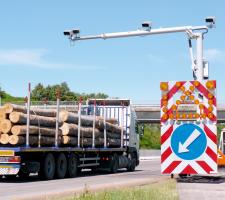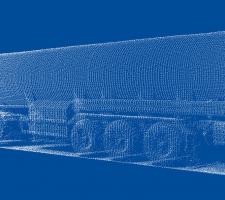
New and conventional business concepts like online shopping and mail order business are becoming more established in the cultures of fast-growing economies and increasing the demand for flexibility in the freight transportation and logistics industry. Road transport has become the preferred infrastructure for freight forwarding and several studies predict it will gain share from other modes such as rail or waterways as the overall volumes increase. They also predict a rise in the proportion of smaller commercial vehicles such as vans and light trucks in comparison to the heavy trucks and the overall fleet.
These developments will increase the load on the road networks and will create several challenges for road operating authorities and future city concepts. In turn these will require new methods and spur intelligent procedures which are being planned to manage both traffic and transport.
Increasing traffic volumes cause several potential problems and traffic safety is one of them. One of the many potential solutions includes autonomous driving for commercial vehicles which is being developed and tested by several automobile manufacturers.
These systems are based on machine vision technology and principles and use a combination of cameras, laser scanning units and sensors for vital subsystems. Systems like proactive collision warning, (emergency) braking assistance, distance control and lane departure warning at the front and the side of the vehicle are complemented with others that recognise traffic signs, enhancing vehicles and thus traffic safety.
Roadside systems
Increasingly the roadside systems used to gather real-time information and data for traffic management and control use optical sensors and components. These utilise machine vision technologies to recognise, identify and classify vehicles on the road for traffic volume determination, road user charging or law enforcement application.
Machine vision offers a flexible framework of technologies, methods and algorithms and evolved in relatively controlled environments in industrial automation, however very early on the pioneers realised the technology’s significance for the traffic sector. At the system level both utilise optical and laser based sensors as well as intelligent computer based (embedded systems) algorithms for front end and centralised or decentralised systems at the backend. Increasingly real-time analysis and data aggregation of the objects is undertaken at the front end and the extracted characteristics sent to the backend for processing.
Experience from the industrial and logistics sectors have been adapted to handle the requirements of ITS applications and the challenging conditions in the traffic environment. Initially machine vision supported high-end ITS applications such as tolling, charging and enforcement, but advances in intelligent imaging components and processor technology means machine vision can now be used for low-end ITS applications. Recent products and system developments are mainly platform based and able to undertake a number of tasks using a single imaging system – that is a single camera with integrated processing unit and a number of embedded algorithms.
Well established market segments such as ANPR, automatic vehicle classification (AVC) and automatic vehicle Identification (AVI) started as simple application of some methods, which were previously used in MV.
The use of ANPR started in the UK for crime prevention and is now being used in various applications. It utilises techniques such as OCR (optical character recognition), BLOB (binary large objects), edge detection, pattern matching, syntactic analysis, neural networks and the like to locate the license plate, read its content and recognise its origin. Now that technology forms the basis of ITS applications including average speed measurement, journey time management, low emission zones, congestion charging, video tolling, express lanes and monitoring of lane restriction (bus lane, hard shoulder).
In addition to ANPR, vehicle finger printing can be used to identify vehicles. One of the approaches relies on the use of a partially recognised plate as a reproducible parameter or characteristic of the particular vehicle. Another uses pattern recognition to match the plate and its surroundings as graphical parameters. These approaches increase the efficiency of data processing in the backend.
In terms of traffic enforcement systems Vitronic favours laser scanner measurement technology (LIDAR, Light Detection and Ranging) which uses similar machine vision technology for part of the electromagnetic spectrum our eyes cannot detect, and can simplify a complex traffic scene. Not only does this enable high-precision measurements of multiple objects over several lanes of traffic, it also eliminates the need to integrate equipment into the road surface.
Back with the visual spectrum, make and model recognition (MMR) provides an automatic description and recognition of the vehicle main parameters (type, make, model and size). This is useful both in tolling applications and also for enforcement evidence and works from the characteristics of vehicle front (lights, grille and bumper) or rear. These features are analysed in the image and parameterised to a descriptor and then compared using cross correlation with a database containing the main patterns of different vehicle types and models.
The combination of ANPR, MMR and vehicle fingerprinting to enrich the process of automatic vehicle identification can identify and categorise vehicles and combat fraud for tolling purposes without requiring an onboard unit. Parking management systems can use such capabilities to assign a particular parking lot for the vehicle according to its type and size.
Vehicle Classification
Vehicle detection (counting) and classification remains a major component of traffic management and control. The use of roadside equipment to collect and aggregate such data and information about the passing vehicle is the basis of demand management and traffic control, the trigger for variable speed limits and diversion to avoid congestion and traffic queuing.But counting alone cannot provide all the necessary information, as heavy goods vehicles occupy more space while their acceleration is slower and their braking distances are larger than passenger vehicles. As a result they leave a comparatively longer headway to the vehicle in front. While this has little effect on flowing traffic, if congestion starts it can mean that a large number of HGVs on the road will often block one complete lane. To derive live information regarding the vehicle mix, a combination of roadside equipment will be required to identify each individual vehicle.
In a large-scale roadside equipment network such as multi-lane free-flow tolling, the position information of the vehicle can then be determined without the need for on-board vehicle units or GNSS. Instead, vehicle detection and classification can be carried out in a non-invasive and non-intrusive manner by using either vision-based or laser-based components - or a combination of both depending on the application requirements. 3D classification delivers precise information of the vehicle profile, the number of axles and the existing of trailers and tow bars. Multiple scanners can be used for higher accuracy to profile and categorise the vehicle and recognise further features.
Investment
While the initial investment expenses of conventional single camera-based classification systems are relatively low, they have relatively high error rate due to environmental factors such as shadow, night view, occlusion, and others. With multi-camera classification systems the ratio between error rate and costs is reverted - the initial costs are higher but the error rate is relatively low. To provide a well-balanced cost/performance ratio the experience and expertise in both areas (machine vision and traffic technology) plays a significant role. By adapting the imaging sensors with the appropriate machine vision to combat the challenges of the traffic environment, a single camera-based classification system achieves the performance of multi-camera-based classification system at a lower price level.While existing vision-based detection and classification system use the shape, length and height of the vehicles as the determining features for classification, robust approaches are able to detect the vehicle, measure its 3D profile, distinguish its axles, estimate its speed and determine its travel direction.
Vitronic combines IR optical classification with laser-based vehicle detection and tracking in a unified system that can be mounted in a roadside housing, independently in enforcement trailers, or on tripods. It is efficient to extend traffic enforcement networks including a toll enforcement network.
Machine vision prepared the road for traffic technology applications as it provides a full suite of technology, sensors and methods. The adaption of machine vision for transportation continues apace and will guide its future.













